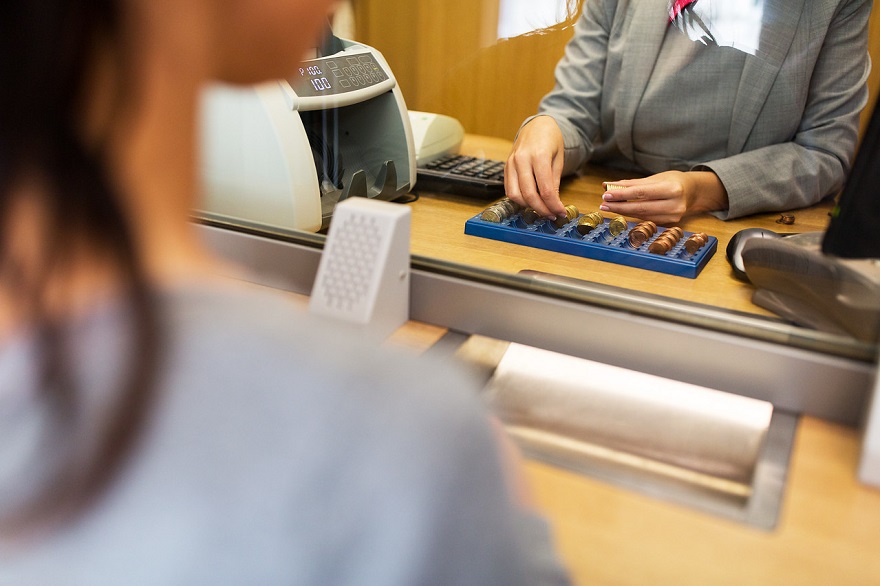In this short guide to ergonomics risk associated with working in bank branches we’ll cover some of the most common ergonomics risks and how to deal with them.
Ergonomics deals with the fit between a workforce, their working environment and the types of work that they do. To understand the relationship between these factors you need to understand the job that’s being carried out, the individual’s physical and psychological characteristics and the organisational and social environment.
These factors can range from the demands of the job, such as the workload and the times of the shift, to the lighting, the management and even the training.
In recent years bank branches have dramatically changed in appearance and in the type of work they do. They may no longer be a focal point in a community and handle much less cash than previously. With the introduction of automated systems and in-store ATMs that enable customers to carry out a wide variety of tasks, the staff have a different role too, often guiding customers through the task, rather than being the person carrying out that task.
Bank branch ergonomics
With that in mind, let’s look at those three areas, the type of work, risks faced by the workforce and the environment, and the factors related to them.
The type of work
- Interacting with customers in the ‘meet and greet’ zones or ‘transaction areas’
- Moving and handling cash
- Back office administration and management activities
- Sitting at counters providing teller services
- Sitting at desks providing mortgage and investment advice
Risks faced by the workforce
- Sedentary work either behind a desk, or, more prevalent now, standing
- Manual handling injuries related to the moving and handling of cash
- Lack of knowledge around ergonomics
- Stress related to job security
The organisational and social environment
- Banks and building societies have invested heavily in branch redesigns, largely from a customer perspective, but also considering ergonomics and manual handling factors
- Changes around the tasks and processes used to deal with customers
- They are committing to health and wellbeing programmes, that often include gym membership, healthy eating advice, advice to stop smoking and health and wellbeing training
- Equipment: Desktop computers, desks, open counters, teller cash recyclers, bags for cash, and other office stationary
- Environment: Traditional branches with vaults, narrow corridors and small back offices, and large, open customer reception areas
What are the common ergonomics risks in branches?
With wide-ranging changes in branches over recent years we now see lower cash volumes coming through the bank or building society, a focus on DIY, digital banking services for customers, and better customer experience that has transformed the look and feel of a traditional bank branch.
For customers this means walls of ATMs and cash machines, comfy seats and waiting areas. For staff, this means drastically different working environments from the past.
Below we go through some of the most common ergonomics risks associated with bank and building society branches.
Moving and handling cash
Moving and handling cash has always been a feature of working in a branch, and as long as people continue to use cash it will remain that way. However, the decline in the use of cash coupled with the digitisation of most banking tasks means that customers no longer need access to physical cash, and banks therefore store much less of it.
While there is less cash the risks are still real. This is further exacerbated by restricted back-office space providing limited access for loading ATM cartridges, moving trolleys, and other equipment.
Ergonomics risk factors related to moving and handling cash:
- Lifting heavy bags to the top or bottom shelves, when heavy bags should be placed at waist height
- Moving heavy bags where necessary due to lack of space to operate a trolley
- Lifting and moving in tight spaces, such as replacing ATM cartridges in the narrow space behind a bank of ATMs
- Lifting and moving in awkward spaces, such as reaching safes that have been placed in corners, on steps, or where existing internal architecture places obstacles between the trolley and the safe
- Bending or reaching to get to time-lock tills, either because they are low down at the teller counter, or where uniforms make bending difficult (particularly in skirts)
What you can do to mitigate moving and handling risks:
- Improve manual handling training and encourage staff to lift and move all loads, whether they’re heavy or light, properly
- Use trolleys where available, but office chairs can also work well in places where trolleys cannot be used
- Put the heavier bag weights on the middle of shelf and move the lighter weights to the top or the bottom
- Stretch regularly, but especially when undertaking periods of heavy lifting, to prevent injury.
Standing for long periods
Banks and building societies deal with customers much differently than they have done in the past. The traditional bank with its large anti-bandit screens has now mostly gone, instead being replaced by ‘meet and greet’ zones, ‘transaction areas’, open space and lines of ATMs that can complete most of the tasks required by bank customers.
This has meant a change in the ergonomics risks for most staff. Where staff would have sat for 8 long hours serving customers behind a screen, now the tellers are often standing and walking out in the open or behind teller counters, where they can quickly support a customer through their tasks.
Ergonomics risk factors related to dealing with customers:
- Long periods of standing still, which can cause sore feet, muscular fatigue, lower back pain, stiffness in the neck and many other musculoskeletal injuries
- Hard floors can exacerbate injuries from prolonged periods of standing
- Poor choice of footwear
- If an employee has moved from a sedentary sitting position to a new job that involves a lot of standing, they may make poor choices related to health, such as inadequate footwear or failing to move enough
What you can do to mitigate risks related to standing for long periods:
- Carpeted areas can provide additional comfort when standing
- Footwear should be stable and include cushioned insoles. Insoles for shoes help to act as a shock absorber, limiting the damage to muscles and joints
- Encourage staff to walk briskly to increase the heart rate and boost circulation
- Improve circulation by encouraging light stretching and exercises when staff have a short amount of free time to themselves
- If a staff member has always worn heels, it’s not always the best idea to ask them to stop as muscles and joints are adjusted to them
Dealing with customers at desks
Mortgage advisors, banking managers and other high value service staff present a common problem for ergonomics risks. These staff will often use a side office with a monitor connected to an arm, a desk with a number of seats for customers and a keyboard and mouse.
Similar ergonomics risks are presented by staff sitting behind anti-bandit screens in the more traditional teller roles.
Ergonomics risk factors related to dealing with customers at desks:
- The position of the monitor, often positioned to the side to prevent a barrier between the customer and bank staff, can mean twisting of the neck and body when looking back and forth between the monitor and customer
- Counters with poor ergonomic design, particularly the traditional teller positions, where security is a key factor of design. These counters have equipment to each side and an off-set screen encouraging twisting and flexing of the neck and back
- Use of tablets or smart devices with touch-screens. Prolonged use can cause musculoskeletal issues
What you can do to mitigate risks related to desks:
- Improve staff training and understanding of ergonomics risks so that staff can make the right decisions for their own bodies
- Teach staff about the correct use and positioning of monitor arms, office chairs, keyboards and other office equipment
- Help staff to make the right choices about where to carry out their work. For example, if an employee needs to fill in paperwork, back office desks might present a better option than those designed for conversations with customers
- Encourage staff to direct customers to sit in the most suitable position to reduce twisting by ensuring they choose where to place the customer chairs
- Ensure staff are taught to use new technology in the best possible way
The key message
Giving branch staff appropriate training and knowledge of ergonomics will help to improve the way they use equipment and the way they interact with their environment. This will ensure that staff are healthier, more productive and avoid absence due to illness.
While every step can be made to ensure that staff have the right equipment and that the workplace is free from danger, if staff don’t have the knowledge to take the right steps to avoid injury it is impossible to mitigate against these risks. Half the problem is acknowledging that even small repeated movements can cause injury, such as moving a heavy bag of cash from one place to another. Although it might only cause a minor strain at the time, over a period of years this type of activity can build up and cause costly injuries to employees.
Whether you’re providing on-site, video or online training, getting the message right is vitally important. Communicating ergonomics risks and training to staff, through notice boards, intranets or via other means will instil an understanding of the potential for injury and help to lessen its chance.
Do you want to help your staff reduce their ergonomics injuries? Cardinus has a suite of banking-specific solutions, contact us today on [email protected] or +44 (0) 207 469 0200.




